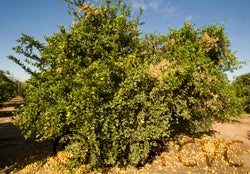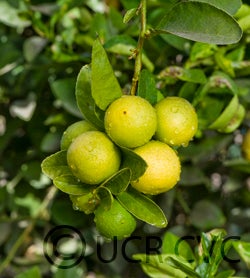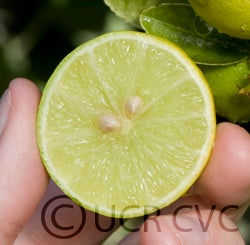Citrus aurantifolia (Christm.) Swingle
CRC 1710
PI 539151
VI 419
Source
Received as budwood from Mel Anderson, Fruit Growers Supply Company, 1927.
Parentage/origins
Parents unknown.
Rootstocks of accession
Yuma Ponderosa lemon
Season of ripeness at Riverside
October to December
Notes and observations
Mexican lime is known by many names such as Key lime, Bartender’s lime, and West Indian lime. The trees are moderately-sized and bushy, almost shrub-like, and the leaves are distinctively aromatic when crushed. Some selections are quite thorny, while other selections are thornless. Mexican lime trees are sensitive to cold. The blossoms are pure white and fragrant. The fruits are small, approximately one and one-half inches in diameter, and almost round, with a thin, smooth, greenish-yellow rind at maturity that is especially fragrant. The flesh is greenish-yellow, seedy, and highly acidic, with a fine texture. Once Mexican limes reach full maturity, usually in autumn to early winter, they drop from the tree.
1985, EMN: From Ora Vista Orange Co., Highgrove, Calif. Buds from 30 year old tree, large vigorous and bears good crops. Had vein enation. This accession had psorosis and exocortis, removed by shoot tip grafting . This treatment probably also removed vein enation earlier noted.
11/09/1987, EMN: Fruit of CRC 1710 (Mexican), 1813 (West Indian), 2188 (Key), and 2449 (Everglade) compared and found to be apparently identical.
Description from The Citrus Industry Vol. 1 (1967)
"Fruit very small, round, obovate or short-elliptical; base usually rounded but sometimes with slight neck; apex also rounded but usually with small, low, and faintly furrowed nipple. Moderately seedy and highly polyembryonic. Rind very thin; surface smooth, leathery; tightly adherent; color greenish-yellow at maturity, following which it drops from the tree. Segments 10 to 12; axis very small and usually solid. Flesh color greenish-yellow; fine-grained, tender, juicy; highly acid with distinctive aroma. Somewhat everbearing but crop comes mainly in winter (earlier in very hot climates).
Tree medium in vigor and size, spreading and bushy with numerous, slender, willowy fine-stemmed branchlets densely armed with small, slender spines. Foliage dense and consists of small, pale green, broadly lanceolate, blunt-pointed leaves with definitely winged petioles. Flower buds and flowers small, and flowering occurs throughout year but mainly in spring and late summer. Not withstanding contrary statements in the literature, the new shoot growth is faintly purple-tinted and flower buds and young flowers faintly purple-tinged. Coloration fades rapidly, however, especially if the weather is warm, and is soon lost. Very sensitive to cold.
The West Indian or Mexican lime is the kaghzi nimbu (numerous modifications and other local names) of India, the limûn baladi of Egypt, the doc of Morocco, the Gallego lime of Brazil, and limon corriente in some Latin American counties. In North America, it is sometimes also called the Key lime.
Because of the relatively high degree of polyembryony exhibited by this fruit, it comes remarkably true to seed, and seed propagation is still employed in most of the countries where its culture is important—India, Egypt, and Mexico. As a consequence, clonal varieties have not been selected and named, except for a few which are noted below. In this connection, it is significant to note that in California it has been found impossible to distinguish between seedling clones of the common acid lime from India, Egypt, and Mexico, and clones of Florida and West Indian from origin budded trees. It seems likely, therefore, that the principal clones employed are genetically identical and that only one horticultural variety is involved, which in California is known as Mexican and in Florida as West Indian or Key.
A nucellar seedling selection arising from the Mexican lime-grapefruit cross was described and named Everglade in 1905 by Webber (1943) in the belief that it produced a larger fruit. In California, it has been indistinguishable from the parent clones and therefore has not come into use. Thornless clones reported in the literature include: Doc Sans Epines (Doc Thornless) of Morocco; Yung, a form introduced into California from Morroco by George Yung about 1882 and described and named by Webber (1943); an introduction from Trinidad (West Indies) received by the United States Department of Agriculture in 1910, a limb sport which was found in the Ballard orchard near Weslaco, Texas, shortly after the freeze of 1925; and a selection recently made at Yuma, Arizona, by J. Hamilton of the U.S. Department of Agriculture. None has proved to have commercial value.
Because they produce distinctive symptoms when infested with the tristeza virus, West Indian lime seedlings are widely used as an indicator in the detection of this disease."
Availability
Commercially available in California through the Citrus Clonal Protection Program. Click here to order budwood.
USDA Germplasm Resources Information Network page for Mexican lime



